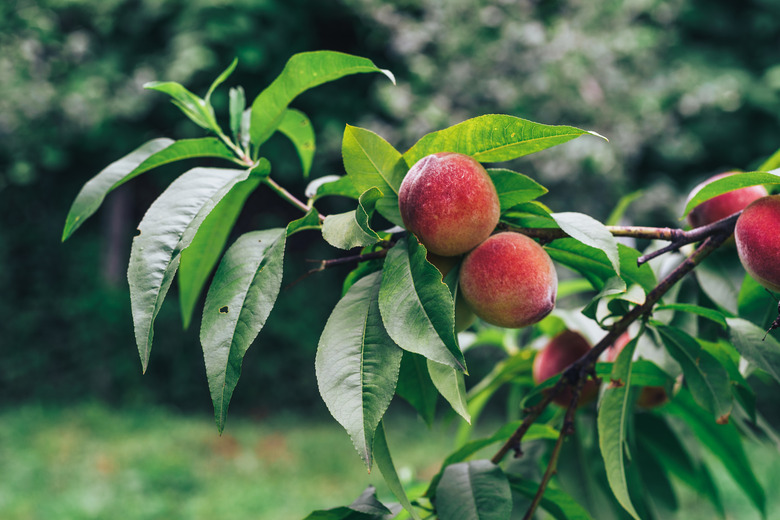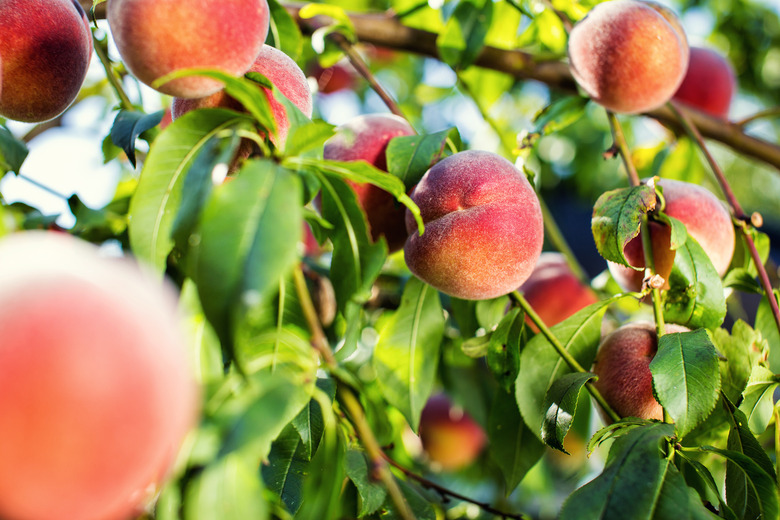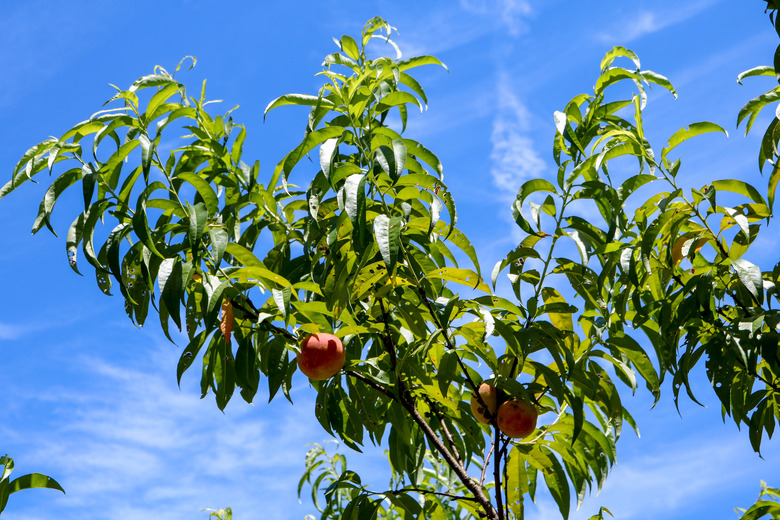How To Grow Peaches
Nothing says summer more than biting into a ripe peach, especially if you are lucky enough to buy some from a local farmers' market. Even better is being able to enjoy this favorite fruit by growing your own peaches (Prunus persica, USDA zones 4-10). While they are not difficult to grow, they do require attention to produce bumper crops of the fruit.
About Peach Trees
Peach trees are deciduous trees that produce pink or white blooms in the early spring. The fruit follows soon after and will ripen from June into August depending on the local climate and the cultivar planted. Standard-size peach trees can reach heights of up to 25 feet, although it is recommended to prune to a top height of about 10 to 15 feet to maximize fruit yield and to keep the fruit within reach when harvesting. The dwarf cultivar, Prunus persica 'Parade,' reaches 6 feet in height in USDA zones 5 through 9.
Peaches have sweet white or yellow flesh, depending on the variety. The fruit is also classified by the type of pit it contains. Freestone peach pits separate easily from the flesh. They are the type most commonly found in grocery stores.
Clingstone peaches have pits that stick to the flesh. They are commonly used in jellies and for canned peaches. There are also donut-shaped peaches as well as nectarines, which are smooth peaches without the fuzz.
Where Do Peaches Grow Best?
In general, peaches can grow in U.S. Department of Agriculture plant hardiness zones 4 through 10, but most cultivars do best in zones 6 to 8. If you live in a colder region, look for cultivars that are bred to withstand the colder winter temperatures, such as Prunus persica 'Contender,' hardy in USDA zones 4 through 8.
Peaches, like most other fruits, require a certain number of chilling hours each winter so that they can produce fruit when the weather warms. Chilling hours are temperatures below 45 degrees Fahrenheit. There is a wide range of chilling hour requirements among peach cultivars. Some require as little as 350 hours, while others need over 1,000 hours.
Determining the chilling hours in your area isn't an exact science because winter temperatures can vary from year to year. It's best to contact your local county extension office or talk with someone at a local garden center to determine the peach cultivars that are best for your area.
When to Plant Peaches?
In warm climates, you can plant new trees in late winter. In colder areas, it is best to wait until spring, especially if the ground freezes during the winter. Plant when the soil is workable but hold off if you expect a hard frost or freeze. Avoid exposing the roots of young trees to freezing temperatures.
Dwarf peach trees can also be planted in pots and placed on patios or decks. Start with a 5-gallon pot. As the tree matures, it may become root-bound. You can then transplant it to a larger pot.
Using Peaches in the Kitchen
Peaches are the unofficial fruit of the summer — perfect for delectable desserts like peach cobbler and peach pies, but they also can be used as an unexpected addition to a savory food such as salsa or even grilled and served alongside a pork chop. Of course, the best and most classic way to enjoy a peach is to pull one out and enjoy for an afternoon snack in the sunshine.
Planning Your Peach Orchard
As with any fruit tree, you will be planting your home orchard where you can easily get to the fruit. While proper pruning should keep the tree about 10 feet tall, it will be as wide as it is tall. Peach trees require full sun for six to eight hours per day for healthiest growth and optimized fruiting potential. Place them so that they are not shaded by other trees or buildings.
If you are planting multiple trees, space standard trees 15 to 20 feet apart. Dwarf cultivars should be spaced 10 to 12 feet apart. As a space-saving measure, you can also espalier peach trees, training semi-dwarf or dwarf trees to grow into a privacy screen on a fence or against a sunny, south-facing wall.
Most peach cultivars are self-fertile, which means the tree will produce fruit when planted alone. However, a different cultivar planted within about 50 feet can increase the yield.
Transplanting Peach Trees
Although you can grow a peach tree from seed, the resulting tree will not grow true to type. This is why peach trees are grafted or budded as the primary method of propagation. Peach trees can be purchased as young saplings (often seen as potted plants) or as bare-root stock. The basic procedures for planting trees apply to peach trees.
For bare-root trees, try to plant them as soon as you receive them. Unwrap the roots and place them in a bucket of water for about one hour. Dig the hole deep and wide enough so that the roots can be spread out, usually about 18 inches deep and wide.
Place the peach tree in the planting hole and have a helper hold the trunk while you fill the hole about halfway. Give the trunk a gentle shake to help distribute the soil among the roots. There may be a bump near the bottom of the trunk where the peach tree was grafted to the root stock. The bump should remain 2 or 3 inches above the ground when the tree is planted.
Continue filling the hole, gently tamping down the soil to eliminate air pockets. Water thoroughly until the soil is saturated. Apply about 3 inches of organic mulch around the base of the tree and pull it 3 to 4 inches away from the trunk.
Many nurseries will pre-prune bare-root trees before they send them to you. If your dealer did not, prune the main trunk to about 30 inches high and the branches back to three or four buds. The pruning gives the delicate roots time to establish themselves in the soil before they need to supply nutrients to the top growth. The tree should produce fruit in two to four years.
Caring for Peach Trees
Peach trees prefer well-drained, fertile soil that is slightly acidic to neutral on the pH scale. The pH is a measurement of the soil's acidity and alkalinity on a scale that runs from 1 to 14. A reading of 7 is considered neutral. To determine the condition of your soil, including what nutrients it may lack, Use a soil test kit or have the soil tested at a garden center or the county extension office.
Newly planted trees do not require fertilizer until the tree starts bearing fruit. If the soil is lacking, based on the results of a soil test, apply a balanced fertilizer about six weeks after planting. Once the tree begins bearing fruit, its nitrogen needs will increase. Plan on applying a high-nitrogen fertilizer every spring.
Water peach trees weekly for the first year unless there is adequate rainfall of about 1 inch per 10-day period. After that, natural rainfall should be all the tree needs except during dry spells. During drought periods, water every week or so.
Thinning peaches once they reach about 1/2 inch in diameter boosts the overall health and size of the crop. Thin by hand so that remaining peaches are 6 to 8 inches apart on the branch.
Winterizing Peach Trees
Peach trees require annual pruning. There is a marked difference in fruit production and overall health between a well-maintained tree and one that is not pruned regularly. Pruning occurs when the tree is dormant, so early spring is the best time for those in colder climates, but for those who live in southern regions where it's warmer, late winter is also an acceptable time to prune.
The goal is to prune the tree into an open-center vase shape. This opens up the tree for maximum sunlight penetration and airflow. It also makes it easier to harvest the peaches.
During the first pruning that occurs in the first dormant season after planting, you will remove the center leader and direct growth to three or four outward-facing branches. When the tree begins to bear fruit, it is important to remember that the fruit grows on second-year wood. Branches that grow during one growing season will support fruit the next growing season. As the tree matures, the pruning requirements change, so it is a good idea to consult an arborist or extension office for advice.
Harvesting Ripe Peaches
Harvest ripe peaches from June through August depending on the cultivar. A peach is ripe when all traces of green are gone, and the peach gives a little when squeezed. Be sure to lift the branch or the fruit to check the color on the underside. Cradle the fruit in your hand and twist gently to remove the fruit from the tree.
Peaches will last for up to two weeks in the refrigerator, but keep them out of the refrigerator for as long as possible. If some of the harvest is a little hard, place the fruits in a paper bag for a few days to soften them.
Monitoring for Pests and Other Problems
Peach trees are susceptible to a number of pests. Stink bugs and lygus bugs are among the insects that are easy to spot because they are large, up to 1/4-inch-long. They harm both blossoms and fruit, and Lygus bugs inject a toxic substance that can deform roots. You can use stink bug traps or insecticides formulated for use against these pests.
Aphids are tiny pinhead-sized bugs that cluster and feed on the underside of leaves, causing the leaves to curl and die. You can remove them with a strong spray from a hose, but you will need to check back frequently to make sure they don't return. You can also remove them with insecticidal soap products.
Tent caterpillars and webworm caterpillars encase sections of the tree in webs, where they feed on the leaves. You can remove the insects and their webs with a broom or rake and then burn the webs.
Many insects overwinter in garden debris. To help prevent an infestation, clean up the area at the end of the season by raking under and around trees. Remove old mulch and apply fresh mulch.
Diagnosing Common Peach Diseases
Crown gall is caused by a bacterium that causes galls, or clumps of plant tissue, to form on roots, root crowns, stems and branches. The galls interfere with the transfer of nutrients throughout the tree, causing stunted growth and decreased fruit production. There is no cure except to remove infected plants as soon as you notice them.
Powdery mildew occurs during humid weather. It turns the leaves white to grayish and forces them to curl. Prevent this fungal infection with careful pruning to provide adequate air circulation. A fungicide, either homemade or commercially prepared, may help reduce or eliminate the infection.
Crown rot and root rot often appear as dark areas on the tree around the crown and upper roots. The areas may ooze a gummy, saplike material. Careful water management and planting on well-draining soil can help prevent these diseases. Consult a county extension agent for fungicide recommendations.


